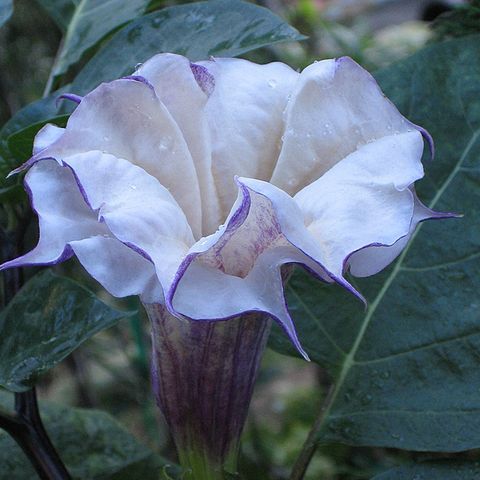Summer-growing annual herbs or short-lived perennials, glabrous or pubescent with glandular or simple, non-glandular hairs. Leaves alternate, simple, entire or lobed, petiolate. Flowers solitary in forks of stems, bisexual, actinomorphic. Calyx tubular, the lobes 5 (occasionally 3, 4 or up to 9); base persistent in fruit. Corolla funnel-or trumpet-shaped, rarely multiple, white or variously coloured; limb shortly 5–lobed or appearing 10–lobed, folded and twisted in bud. Stamens usually 5, equal in height, inserted in lower half of corolla-tube. Anthers bilocular, basifixed, dehiscing by longitudinal slits. Ovary bilocular, or falsely 4–locular in lower half; stigma saddle-shaped. Fruit a 2–4–locular, spiny or tuberculate capsule, opening regularly or irregularly from apex. Seeds approximately D-shaped.
lower, variously pubescent, the anthers oblong and slightly curved, blasifixed, dehiscing longitudinally, free; ovary conical, 4-loculed by proliferation of the placentae, the ovules many, the stigma variously shaped. Fruit a leathery 4-celled capsule, mostly locucidally dehiscent terminally to about halfway down, usually covered with soft or woody spines, more or less globose; seeds large, mostly black, flattened and roughened; embryo circinnate in fleshy endosperm. A genus of about ten species of warm temperate regions in both New and Old Worlds. Eight species are native to Mexico and the southern United States, which region may be considered a center of speciation. Commonly occurring as ruderal weeds, one species of Mexico is paludal. Some species are nocturnally scented.
Shrubs or annual or perennial herbs; pubescence of simple sometimes glandular hairs. Leaves petiolate; leaf blade simple, entire or sinuate-dentate. Inflorescences solitary flowers in leaf axils or in branch forks; peduncle, bracts, and bracteoles absent. Flowers actinomorphic, large. Pedicel often stout. Calyx long tubular or cylindric, often circumscissile near base. Corolla elongated, funnelform; lobes sometimes cuspidate. Anthers mostly elongated, dehiscing longitudinally, included. Ovary 2-4-locular. Fruit a dry capsule, 4-valved or irregularly dehiscent, prickly or unarmed, often subtended by remnants of persistent calyx. Seeds numerous, laterally compressed; embryo curved.
Cal cylindric or prismatic, generally circumscissile near the base, leaving a flaring collar under the fr; cor elongate-funnelform, very large, the lobes well developed or represented by slender projections; anthers longitudinally dehiscent, much shorter than the filaments; fr a 2-carpellate, 4-locellar, mostly spiny capsule, generally opening by 4 apical valves; seeds numerous, flattened, with curved embryo; narcotic, poisonous herbs or woody plants with large, entire to toothed or lobed lvs; fls terminal and solitary in origin, later appearing to be borne in the forks of the branches. 25, neotrop. and warm-temp., now widely intr.
Unarmed, annual or perennial herbs, or low subshrubs. Lvs alternate, simple, rather large, membranous, often hairy, at least when young, entire, toothed or lobed, petiolate. Fls tending to form leafy cymose infls, ± erect. Calyx 5-toothed but teeth often small, circumscissile. Corolla large, usually narrow-to broad-funnelform, plicate, white to purple, 5-toothed. Stamens 5, inserted near base of corolla tube, included to slightly exserted. Stigma 2-lobed. Capsule dehiscing by 4 valves, ± spinose, erect or pendent. Seeds many, of moderate to fairly large size, to 6 × 4.5 mm.
Seeds numerous, relatively large, laterally compressed, wedge-shaped or reniform, or ± oblong in outline, sometimes with a funicular caruncle (elaiosome); testa moderately crustaceous, hard, or moderately subereous, very thick, smooth or roughened; embryo ± circinnate, flattened, subperipheral, in the fleshy or horny endosperm, with radicle terete; cotyledons semi-terete or linear in outline.
Calyx shorter than the corolla tube, tubular, usually 5-angled to 5-ribbed, somewhat inflated or appressed to the corolla tube, 5-lobed or narrowly toothed; tube circumscissile near the base after anthesis, leaving an annular basal remnant which in fruit is often enlarged into a spreading or reflexed shield or cup; lobes much shorter than the tube, with valvate aestivation.
Corolla white or violet to purplish, infundibuliform to ± tubular, sometimes double or triple; tube long and narrow widening towards the throat; limb broad, plicate, spreading, 5(6)-lobed, or 10(12)-lobed when a secondary lobe appears between the main lobes; lobes short and cuspidate or sometimes long-caudate, with a conduplicate-contorted aestivation.
Annual or short-lived perennial herbs or sometimes subshrubs or shrubs from a woody rootstock, often foetid, glabrous or pubescent to glabrescent; indumentum of erect to appressed, simple non-glandular to glandular trichomes, dense on immature foliage, pedicels and calyces, sparse or absent on mature parts, or sometimes remaining pubescent.
Fruit a capsule, globose to ellipsoid or ovoid, erect or deflexed, leathery, covered with soft or woody spine-like excrescences or tubercles (rarely smooth), semi-4-locular, apically dehiscent by 2 loculicidal and sometimes also 2 septicidal slits to ± halfway, the 4 dry valves incomplete.
Ovary ± globose, provided with soft excrescences (rarely smooth), 2-locular, sometimes with a false septum and 4-locular below; ovules numerous in each locule on placentas adnate to the septa, hemicampylotropous; style slender; stigma often 2-lobed to 2-lamellate at the tip, included.
Stamens (4)5(6), ± equal, included or slightly exserted; filaments linear-subulate, adnate to the lower half of the corolla tube; anthers basifixed, linear-oblong to narrowly elliptic or ovate in outline, slightly curved, dehiscing by longitudinal slits.
Leaves alternate, the upper ones in the floral region sometimes in pairs appearing opposite with one larger than the other, petiolate, entire or deeply or shallowly sinuate-dentate or coarsely and sharply incised-dentate.
Flowers usually solitary, axillary or in the forks of the branching stem, actinomorphic or almost so; pedicels ± erect but sometimes becoming pendulous in fruit.
Disk none.

